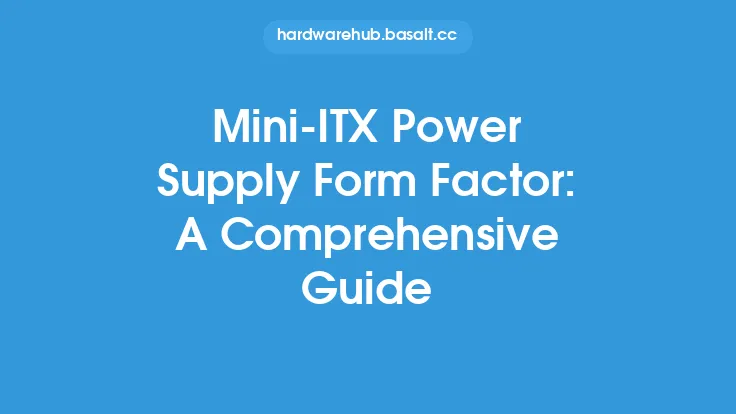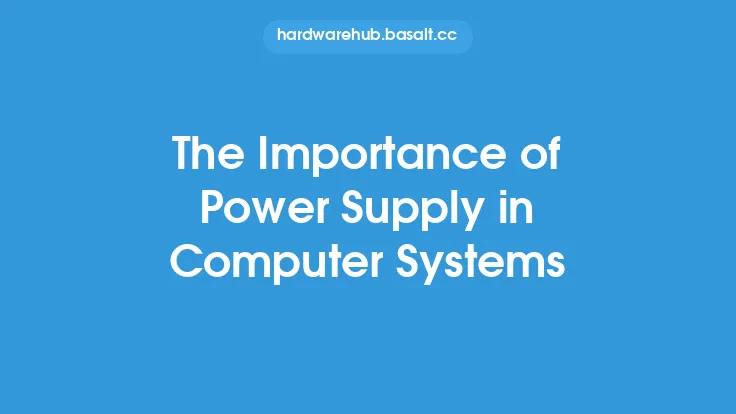When it comes to building an eco-friendly computer, one of the most critical components to consider is the power supply. The power supply is responsible for converting AC power from the wall outlet to DC power that the computer's components can use. However, not all power supplies are created equal, and some are more efficient than others. In this article, we will delve into the world of power supply efficiency and explore why it is a key factor in building an eco-friendly computer.
What is Power Supply Efficiency?
Power supply efficiency refers to the ability of a power supply to convert AC power to DC power with minimal loss of energy. This is typically measured by the power supply's efficiency rating, which is expressed as a percentage. For example, an 80% efficient power supply will convert 80% of the AC power it receives into usable DC power, while the remaining 20% is lost as heat. The higher the efficiency rating, the less energy is wasted, and the more eco-friendly the power supply is.
How is Power Supply Efficiency Measured?
Power supply efficiency is measured using a variety of methods, including the 80 PLUS certification program. This program tests power supplies at different loads (20%, 50%, and 100%) and measures their efficiency at each load. The results are then used to determine the power supply's efficiency rating, which can range from 80% (Bronze) to 90% (Gold) to 94% (Platinum) and even 80% (Titanium). The 80 PLUS certification program is widely recognized as the industry standard for measuring power supply efficiency.
Types of Power Supply Efficiency
There are several types of power supply efficiency, including:
- Linear Power Supply Efficiency: This type of efficiency refers to the ability of a power supply to maintain its efficiency across different loads. A linear power supply will typically have a high efficiency rating at high loads, but a lower efficiency rating at low loads.
- Switch-Mode Power Supply Efficiency: This type of efficiency refers to the ability of a power supply to switch between different modes of operation to optimize efficiency. Switch-mode power supplies are typically more efficient than linear power supplies, especially at low loads.
- Active Power Supply Efficiency: This type of efficiency refers to the ability of a power supply to actively monitor and adjust its operation to optimize efficiency. Active power supplies are typically the most efficient type of power supply, but they can also be more expensive.
Factors Affecting Power Supply Efficiency
There are several factors that can affect power supply efficiency, including:
- Component Quality: The quality of the components used in the power supply can have a significant impact on its efficiency. High-quality components, such as capacitors and inductors, can help to minimize energy loss and optimize efficiency.
- Design and Layout: The design and layout of the power supply can also impact its efficiency. A well-designed power supply with a efficient layout can help to minimize energy loss and optimize efficiency.
- Operating Temperature: The operating temperature of the power supply can also impact its efficiency. Power supplies that operate at high temperatures can experience a decrease in efficiency, while those that operate at lower temperatures can experience an increase in efficiency.
- Load Profile: The load profile of the power supply can also impact its efficiency. Power supplies that are designed to operate at high loads can experience a decrease in efficiency at low loads, while those that are designed to operate at low loads can experience an increase in efficiency at high loads.
Benefits of High Efficiency Power Supplies
High efficiency power supplies offer several benefits, including:
- Reduced Energy Consumption: High efficiency power supplies can help to reduce energy consumption, which can lead to cost savings and a reduced carbon footprint.
- Increased Reliability: High efficiency power supplies are typically more reliable than low efficiency power supplies, as they experience less heat buildup and stress on their components.
- Longer Component Lifespan: High efficiency power supplies can also help to extend the lifespan of the computer's components, as they experience less heat buildup and stress.
- Reduced Noise: High efficiency power supplies can also help to reduce noise, as they typically produce less heat and vibration than low efficiency power supplies.
Conclusion
In conclusion, power supply efficiency is a critical factor in building an eco-friendly computer. By choosing a power supply with a high efficiency rating, you can help to reduce energy consumption, increase reliability, and extend the lifespan of your computer's components. When selecting a power supply, be sure to consider factors such as component quality, design and layout, operating temperature, and load profile, as these can all impact the power supply's efficiency. By doing your research and choosing a high efficiency power supply, you can help to build a computer that is not only powerful and reliable but also eco-friendly.





